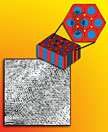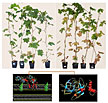- Number 357 |
- February 27, 2012
-
Brookhaven scientists help develop model for future accelerators
 Working with an international team, three physicists from DOE's Brookhaven Lab have helped to demonstrate the feasibility of a new kind of particle accelerator that may be used in future physics research, medical applications, and power-generating reactors. The team reported the first successful acceleration of particles in a small-scale model of the accelerator in a paper published in Nature Physics.
Working with an international team, three physicists from DOE's Brookhaven Lab have helped to demonstrate the feasibility of a new kind of particle accelerator that may be used in future physics research, medical applications, and power-generating reactors. The team reported the first successful acceleration of particles in a small-scale model of the accelerator in a paper published in Nature Physics.
The device, named EMMA and constructed at the Daresbury Laboratory in the UK, is the first non-scaling fixed field alternating gradient accelerator, or non-scaling FFAG, ever built. It combines features of several other accelerator types to achieve rapid acceleration of subatomic particles while keeping the scale — and therefore, the cost — of the accelerator relatively low.
-
Berkeley Lab produces nanorods to order
Nanorods – rod-shaped crystals of semiconductor materials whose dimensions are measured in mere billionths of a meter – are central to many schemes for solar cells, magnetic storage devices, and sensors that depend on arrays of these crystals in composite with polymers. Only nanorods that can assemble themselves into complex structures and hierarchical patterns can fully realize this technological promise, however.
A new technique developed by researchers at DOE’s Lawrence Berkeley National Laboratory (Berkeley Lab) delivers self-assembling arrays of nanorods with improved mechanical and electrical properties, which can be grown relatively quickly, easily, and inexpensively when combined with polymers. -
Out of this world
Using models similar to those used in weapons research, Lawrence Livermore scientists may soon know more about exoplanets, those objects beyond the realm of our solar system.
In a new study, scientists at DOE's Lawrence Livermore National Laboratory and collaborators came up with new methods for deriving and testing the equation of state (EOS) of matter in exoplanets and figured out the mass-radius and mass-pressure relations for materials relevant to planetary interiors. -
Studying the chemistry as it happens in catalytic reactions
While retaining their speed, catalysts have lost some of their secrets, thanks to a new probe built by scientists at DOE’s Pacific Northwest National Laboratory to help clarify the steps catalysts take in promoting reactions. The new device is called a large-sample-volume constant-flow magic angle spinning probe for use in a nuclear magnetic resonance spectrometer. With it, scientists can flow a gaseous reaction mixture through a solid catalyst and collect NMR data on the intermediates and products generated during the reaction. In addition, using NMR can provide structural information about the catalyst itself during the reaction.
"Scientists have been trying for a long time to get something closer to a realistic environment with NMR data. This is the newest approach to doing that," said Dr. Charles Peden, a catalysis researcher in the Institute for Integrated Catalysis at PNNL who worked on the study. -
More grapes, less wrath
A team of researchers has found a way to ensure that your evening glass of wine will continue to be available, despite the potential attack of Xylella fastidiosa (Xf), a bacterium that causes Pierce's Disease and poses a significant threat to the California wine industry's valuable grapevines.
Researchers from DOE's Los Alamos National Laboratory, University of California at Davis, and the U.S. Department of Agriculture's Agricultural Research Service have created specially engineered grapevines that produce a hybrid antimicrobial protein that can block Xf Infection.






